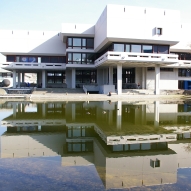Zusammenfassung
Bacillus anthracis causes anthrax disease and exerts its deleterious effects by the release of three exotoxins, i.e. lethal factor, protective antigen and edema factor EF), a highly active calmodulin-dependent adenylyl cyclase (AC). However, conventional antibiotic treatment is ineffective against either toxemia or antibiotic-resistant strains. Thus, more effective drugs for anthrax treatment are ...
Zusammenfassung
Bacillus anthracis causes anthrax disease and exerts its deleterious effects by the release of three exotoxins, i.e. lethal factor, protective antigen and edema factor EF), a highly active calmodulin-dependent adenylyl cyclase (AC). However, conventional antibiotic treatment is ineffective against either toxemia or antibiotic-resistant strains. Thus, more effective drugs for anthrax treatment are needed. We investigated structural requirements for EF inhibition by natural purine and pyrimidine nucleotides and nucleotides modified with N-methylanthraniloyl (MANT)- or anthraniloyl groups at the 2’/3’-O-ribosyl position. MANT-CTP was the most potent EF inhibitor (Ki, 100 nM) among 16 compounds studied. MANT-nucleotides inhibited EF competitively. Activation of EF by calmodulin resulted in effective fluorescence resonance energy transfer (FRET) from tryptophan and tyrosine residues located in the vicinity of the catalytic site to MANT-ATP, but not MANT-CTP. Mutagenesis studies revealed that F586 is crucial for FRET to MANT-ATP and that mutations N583Q, K353A and K353R differentially alter the inhibitory potencies of MANT-ATP and MANT-CTP. Docking approaches relying on crystal structures of EF indicate similar binding modes of the MANT nucleotides with subtle differences in the region of the nucleobases. In conclusion, like mammalian membranous AC and Bordetella pertussis AC toxin, EF accommodates both purine and pyrimidine nucleotides.. The unique preference for the base cytosine offers an excellent starting point for the development of EF inhibitors with specificity for the toxin.




 Altmetric
Altmetric